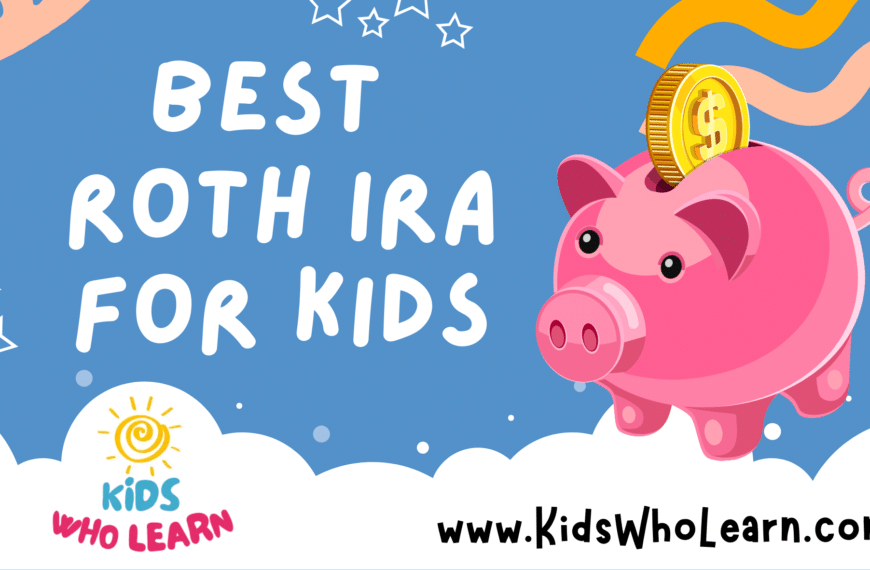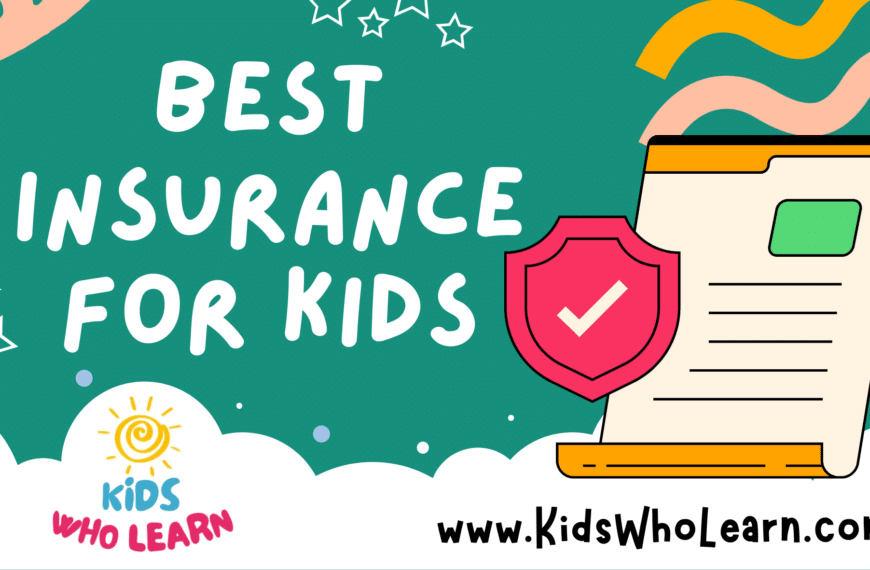Cultivating financial literacy in children is an essential part of their education, and setting up a savings account for them is a great starting point. A savings account designed specifically for kids not only provides a safe place for their money but also serves as an educational tool, teaching them about the value of money, the importance of saving, and how interest works. By actively participating in their own financial growth, kids can learn good money habits from an early age.
Selecting the best savings account for your child involves considering several factors. It’s important to look for accounts that offer competitive interest rates to maximize the savings potential. Additionally, accounts should be accessible and manageable, with features such as online banking that allow children to observe their progress. Other considerations might include the account opening process, any associated fees, and the availability of additional banking services as they grow. Safety and security are paramount, ensuring your child’s money is protected.
Key Takeaways
- A kid’s savings account is fundamental for teaching financial literacy and establishing good saving habits.
- Choose accounts with strong interest rates, low fees, and user-friendly management tools to facilitate learning and growth.
- Safety, accessibility, and accounts that grow with the child are critical factors in selecting the right savings solution.
Why Savings Accounts for Kids Matter
Introducing your child to a savings account can be a significant step toward lifelong financial success. By opening a savings account, you lay the foundation for essential skills such as financial education and effective money management.
Building Financial Literacy
Financial Education: As your kids watch their savings grow, they learn about interest and the value of money. This hands-on education is crucial in a world where financial literacy is a core life skill.
- Understanding Value: Kids learn to gauge the worth of money relative to time and effort.
- Concepts Made Real: Simple banking concepts become tangible experiences that reinforce learning.
It’s about more than just numbers; it’s about real-world context.
Early Money Management Skills
Money Management: A savings account serves as your child’s first step in budgeting and setting savings goals. They learn to allocate funds for different purposes and begin to understand the importance of planning for the future.
- Budgeting Basics: Distinguish between needs and wants.
- Goal Setting: Encourage setting and achieving short-term and long-term financial targets.
These skills lay a solid foundation for mature financial decision-making.
Long-Term Savings Benefits
Savings Goals: Establishing savings goals promotes patience and dedication. Kids learn the satisfaction of reaching a goal and the discipline required to save over time, which are key attributes for financial success.
- Immediate Rewards: Instant gratification is replaced with the joy of reaching a savings milestone.
- Preparation for the Future: Early savings can help fund education or major life events.
Starting young instills a mindset that prioritizes saving for the future.
Key Features of Kids Savings Accounts
When selecting a kids savings account, it’s important to consider factors like how much interest the account will earn and the fees associated with it. Easily accessible funds through ATM or debit card use can make the account more practical for day-to-day learning about financial responsibility.
Interest Rates and APY
- Interest Rates: Look for accounts that offer competitive interest rates to maximize the growth of the savings over time.
- Annual Percentage Yield (APY): The APY is a more accurate measure of potential earnings, as it accounts for compound interest.
Fees and No Fees Options
- No Monthly Fees: Ideally, choose an account without monthly maintenance fees to ensure all deposits contribute towards saving.
- Other Fees: Be aware of fees for additional services, such as ATM use outside of the bank’s network or for account inactivity.
Account Balance Requirements
- No Minimum Balance: Some accounts don’t require a minimum balance, which is helpful for starting small and growing over time.
- Minimum Balance to Earn Interest: Certain accounts might require a minimum balance to earn interest, so it’s important to check this threshold.
ATM and Debit Card Access
- Debit Card: Having access to a debit card can help teach kids how to manage digital transactions responsibly.
- ATM Limits: Understand the limits on ATM withdrawals or deposits, as they help safeguard the account and teach budgeting.
Selecting the Right Account for Your Child
Choosing the right savings account for your child involves comparing institutions and account features while considering mechanisms for parental oversight.
Credit Union vs Banks
Credit Union: Credit unions like Alliant Credit Union and BECU are member-owned, with potentially lower fees and better interest rates. Membership requirements can vary, but often include residence, employment, or affiliation with a certain group.
Banks: Traditional banks offer a broader branch network, which is an advantage if in-person banking is preferred. However, charges and interest rates might not be as competitive as those offered by credit unions.
Assessing Account Features
| Feature | Credit Union | Bank |
|---|---|---|
| Interest Rates | Typically higher | Can be lower |
| Fees | Lower or none | Might be higher |
| Service | Personalized | Professional, but can be less personal |
| Accessibility | Membership reliant | Generally more accessible |
Ensure the chosen institution (whether it’s Alliant Credit Union, Spectrum Credit Union, or a brick-and-mortar bank) provides an account that supports your child’s financial growth and aligns with saving goals.
Parental Controls and Monitoring
Parental controls offered by the institution ensure you can monitor account activity. Look for accounts that allow you as the parent or guardian to set transaction limits, track account balances, and receive alerts. This fosters financial responsibility in your children while allowing you oversight for their security and education.
Account Opening Process
When opening a savings account for kids, it’s crucial to understand the necessary documentation, initial deposits, and how to manage and set savings goals effectively.
Documentation and Application
To start the application process, you’ll need to provide identification for both you and your child, such as birth certificates or passports. The application will require personal details, including Social Security numbers. Financial institutions might also ask for proof of address using documents like a utility bill or a bank statement.
- Identification for you and your child: Birth certificate or passport
- Personal details needed: Names, Social Security numbers
- Proof of address: Utility bill or bank statement
Initial Deposits and Managing Money
After the application is approved, an initial deposit is often required to activate the account. The amount varies, but it’s typically a minimal sum. You should also inquire about the methods for depositing and withdrawing funds, to efficiently manage money.
- Initial deposit requirement: Usually a minimal amount
- Managing money: Learn about depositing and withdrawal methods
Setting Up Savings Goals
Savings accounts for kids often come with tools to help set and track savings goals. Utilizing these tools can teach valuable lessons about saving and financial planning. Establish clear goals and monitor progress regularly.
- Tools available: Use bank’s tools for setting and tracking goals
- Lesson in savings: Teach your child about saving and financial planning through goal setting
Top Savings Accounts for Kids
When choosing the best savings accounts for kids, consider accounts that offer competitive interest rates, low fees, and educational resources to help your child learn about saving money.
Alliant Credit Union Kids Savings Account
Alliant Credit Union offers the Kids Savings Account, which is designed to teach children the value of saving early. This account earns a competitive annual percentage yield (APY) and has no monthly service fees, making saving more effective for your child. There is a minimum deposit required to open the account, but Alliant reimburses ATM fees, up to a specified limit, giving you and your child easy access to funds.
Capital One Kids Savings Account
The Capital One Kids Savings Account features an attractive interest rate with no monthly fees or minimum balance requirements. Your child can watch their savings grow while learning financial responsibility. Capital One also provides an interactive mobile app, allowing you and your child to manage the account together.
PNC Bank ‘S is for Savings’ Account
PNC Bank introduces the concept of saving with its ‘S is for Savings’ Account. This account pairs an engaging online banking experience with Sesame Street characters to make financial learning fun for children. It offers automated savings with the ‘Auto Savings’ feature, and there are no monthly service fees for account holders under 18 years of age.
Additional Banking Services for Teenagers
As a teenager, you have specific financial services designed to meet your banking and investment needs. Here’s how you can make the most of them.
Teen Checking Accounts
Teen checking accounts offer you the independence to manage your money with less oversight from your parents. These accounts typically come with no or low minimum balance requirements and waived monthly fees, making them an ideal starter account for daily transactions. Most of the best teen checking accounts also feature:
- Debit cards for convenient spending
- Mobile banking apps for easy account monitoring
- Spending limits and parental controls to help manage the risks of overspending
- Educational resources to build financial literacy
Here’s a comparison of some top teen checking account options:
| Account Name | Minimum Balance | Monthly Fee | Features |
|---|---|---|---|
| Account A | $0 | $0 | Parental controls, No ATM fees |
| Account B | $0 | $0 | Rewards program, Mobile deposits |
| Account C | $0 | $0 | Customizable debit card, Spending caps |
Financial Products for Young Investors
Investing as a teenager allows you to start building wealth early. Financial products suitable for young investors often include custodial accounts, like the UGMA/UTMA, which transition to your control when you reach the age of majority. These investment accounts can hold various assets like stocks, bonds, and mutual funds. Consider the following before investing:
- Risk tolerance: How much volatility can you stomach?
- Investment goals: Are you saving for college, a car, or just to grow your wealth?
- Time horizon: The longer you have to invest, the more risk you can potentially take on.
Remember, the sooner you start investing, the more you can take advantage of compound interest.
Maximizing Savings Potential
To build your child’s savings effectively, consider options that maximize returns and take advantage of additional benefits.
High-Yield Savings Accounts
You should look for high-yield savings accounts offered by various financial institutions as they generally provide a higher interest rate compared to traditional savings accounts. This higher rate translates directly into more earnings on the saved capital, bolstering the growth of your child’s savings over time. Ideally, seek out accounts that offer no minimum balance requirement to avoid unnecessary fees which can erode your child’s savings.
Banking Bonuses and Rewards
Keep an eye out for bonuses and rewards programs when selecting a savings account for your child. Many institutions run promotions that offer monetary bonuses for opening new accounts or hitting certain deposit thresholds. These bonuses can provide an immediate boost to your child’s savings. Always be sure to read the fine print as some bonuses stipulate specific conditions, like maintaining a certain balance for a set period of time.
Online Banking and Digital Tools
In today’s digital age, having a savings account for your child is about more than just storing money. It’s about accessibility and learning. Online banking offers a range of tools and resources that can educate and engage children in managing their finances from an early age.
Mobile Banking Apps and Features
Mobile banking apps are essential for modern savings accounts. For example, Alliant’s Kids Savings Account comes with an app that helps you manage your child’s funds with ease. Features may include:
- Real-time balance checks: Stay informed about the account balance.
- Fund transfers: Quickly move money into your child’s savings account.
- Deposit checks remotely: No need to visit a branch, deposit checks using your phone camera.
- Set savings goals: Teach your child about financial milestones by setting and tracking goals.
These apps often also include financial education tools. For instance, built-in quizzes or games that make learning about money fun and interactive.
Educational Resources for Kids
Your child’s financial literacy is crucial. Many digital banking platforms provide educational resources, forming part of a larger learning center. These resources can help your child understand the value of saving, how interest works, and the basics of personal finance. They can be:
- Interactive tutorials on banking basics
- Engaging videos about saving and spending
- Articles and advice tailored for young audiences
- Accessible within the mobile banking app or via the bank’s website
Digital Banking Benefits
The benefits of digital banking for kids extend beyond convenience. Here’s why it’s a good choice:
- Accessibility: Your child can check their savings anytime, fostering a sense of ownership and responsibility.
- Safety: Digital banking is secure, with many apps requiring multi-factor authentication to protect the account.
- Tracking: Monitor account activity together and discuss spending choices and saving habits.
Utilizing these digital tools helps to lay a strong foundation for your child’s financial future.
Understanding Taxes and Legal Considerations
When it comes to savings accounts for kids, it’s important to understand the tax requirements and legal frameworks that govern these financial vehicles. This will ensure you’re managing your child’s savings both legally and efficiently.
Tax Implications for Minors’ Income
Your child’s savings account may generate interest, which is considered unearned income. For 2023, if your child’s total unearned income is less than $1,150, it is not subject to federal taxes. However, if the unearned income is between $1,150 and $2,300, it’s taxed at the child’s tax rate. Beyond $2,300, such income is taxed at your rate, which could be higher. This is known as the “kiddie tax,” designed to prevent parents from avoiding taxes by shifting large amounts of investments to their children’s names.
| Unearned Income Range | Tax Treatment |
|---|---|
| Less than $1,150 | No federal tax |
| $1,150 to $2,300 | Taxed at child’s rate |
| Greater than $2,300 | Taxed at parent’s rate (Kiddie Tax) |
Custodial Accounts and Trust Laws
Custodial accounts, such as UGMA and UTMA, allow you to open an account in your child’s name, under trust laws. You, as the custodian, manage the account until the child reaches the age of majority (18 to 21, depending on the state). At that point, they gain control over the account. It’s important to recognize that funds placed in these accounts are irrevocable gifts to the minor – once contributed, the funds belong to the child and cannot be taken back. Moreover, such accounts must adhere to trust laws which vary by state, adding an extra layer of legal consideration. With custodial accounts, keep in mind:
- Contributions are irrevocable
- The minor owns the account
- Managed by a custodian until the child reaches the age majority
- Not tax-deferred; earnings are subject to federal and possible state taxes
Practical Tips for Parents and Guardians
When it comes to managing savings accounts for kids, your role is pivotal. Emphasize the importance of financial education and adult supervision.
Teaching About Budgeting and Saving
Start by clearly explaining how money works and the value of saving. Use concrete examples, like saving for a toy, to illustrate the concept of delayed gratification. Introduce the basics of budgeting by setting simple spending and saving goals together.
- Practical Exercise:
- Create a savings chart with your child, tracking progress towards a specific goal.
- Discuss saving a portion of money received from gifts or chores.
Incorporating Allowance into Savings
Regular allowance provides a hands-on opportunity for kids to learn about managing money. Decide on a fixed amount that aligns with their age and responsibilities.
| Age | Weekly Allowance | Saving (%) | Spending (%) |
|---|---|---|---|
| 5-6 | $5 | 50% | 50% |
| 7-9 | $7 | 60% | 40% |
| 10-12 | $10 | 70% | 30% |
- Savings Tip:
- Encourage your child to deposit a consistent portion of their allowance into their savings account.
Monitoring and Adjusting Financial Goals
Review and adjust savings goals periodically to match your child’s growing interests and changing priorities. Act as a custodian to their account and ensure it aligns with their financial education.
- Account Review:
- Schedule monthly reviews of the savings account to assess progress and make necessary adjustments.
- Celebrate milestones to encourage continued interest in saving and budgeting.
By actively guiding your child through the process of saving and budgeting, you lay a strong foundation for their financial future.
Safety and Security
When selecting a savings account for your child, it’s crucial to ensure it’s equipped with robust safety measures and reliable fraud protection.
FDIC Insurance and Account Safety
Your child’s savings are secured up to $250,000 by the Federal Deposit Insurance Corporation (FDIC), providing peace of mind that their money is protected in the event of a bank failure. Additionally, many banks offer options for direct deposits, which are not only convenient but also reduce the risk of lost or stolen checks.
Available Features:
- FDIC Insured: Savings are protected up to $250,000.
- Direct Deposit: Safer and more convenient than handling checks.
Online Security and Fraud Protection
A savings account for your child should come with strong online security measures. Ensure that the bank provides robust encryption and fraud monitoring. The ability to access free ATMs can minimize the need to carry cash, which reduces the risk of theft. At the same time, be aware that while some accounts may charge a membership fee, others may offer complimentary perks. Always verify if there are overdraft fees and how the bank handles them, as this could impact your child’s account.
Security Checklist:
- Encryption & Monitoring: To protect your personal information online.
- Free ATM Access: Reduces the need to carry cash.
- Membership Fee: Verify whether applicable or not.
- Overdraft Fees: Understand the charges to avoid unnecessary costs.
- Physical Branch Locations: Confirm availability for in-person assistance if needed.
Account Management and Growth
Effective account management and consistent growth are essential for maximizing the benefits of a savings account for your child. Monitoring interest rates and adjusting account features are key to building a healthy account balance over time.
Regular Deposits and Interest Monitoring
You should establish a habit of making regular deposits into your child’s savings account. This not only fosters a good savings discipline but also contributes to the compounding of interest. Watch the account’s Annual Percentage Yield (APY) closely; higher APYs yield more return on your deposited funds.
- Interest Calculations: APY affects how much interest the account earns. A competitive APY means more growth for your child’s savings.
- Balance Check: Regular monitoring ensures the interest rate promised matches the growth seen in the account balance.
- Capital One Example: Capital One offers accounts with competitive APYs that could benefit your child’s long-term savings goals.
Interest earned on a savings account is usually compounded daily and posted monthly. This means the interest rate, often expressed as an APY, capitalizes on the previous interest earned, gradually increasing the account balance.
Adjusting Account Features as Child Grows
As your child grows, their financial needs will change, and so should the features of their savings account. A flexible account where features can be adjusted is valuable.
- Account Tiers: Some banks offer tiered interest rates, where higher account balances receive higher interest rates. As your child’s savings grow, ensure their balance qualifies for the best available rate.
- Feature Adjustments: Age milestones can mean adjusting account features — for example, transitioning to accounts with a debit card feature as your child learns about spending and budgeting.
It’s important to reassess the account’s terms regularly to ensure that the savings account continues to offer a competitive APY and that it aligns with your child’s developing financial awareness and needs.
Transitioning to Adult Financial Products
As you approach adulthood, managing your finances becomes more complex. It’s crucial to understand how to smoothly transition from youth-oriented savings options to financial products designed for adults.
From Youth Savings to Teen Checking
Moving from a youth savings account to a teen checking account is a significant step in your journey toward financial independence. You should look for a checking account that offers no monthly fees, online banking access, and perhaps even interest on your balance. Understand that with a checking account comes responsibility—keeping track of your spending and maintaining a positive balance becomes crucial.
- Features to Look For:
- No monthly maintenance fees
- Online and mobile banking
- Debit card availability
- Overdraft protection options
- Responsibilities:
- Monitor account activity regularly
- Manage spending to avoid overdraft
Considerations for Credit Cards and Loans
As you become eligible for credit cards and loans, it’s important to understand their impact on your personal finance and financial goals. Credit cards, if used wisely, can help build your credit score, which is valuable for future financial endeavors like taking out a loan or renting an apartment. Look for cards with low interest rates and no annual fees to start. Loans should be taken with a clear repayment plan in mind, ensuring they align with your financial goals and have favorable terms.
- Credit Card Considerations:
- Low APR (Annual Percentage Rate)
- Minimal or no annual fees
- Rewards or cash-back on purchases
- Reporting to credit bureaus to build your credit history
- Loan Considerations:
- Understand the loan’s interest rate and fees
- Ensure the repayment plan is manageable within your budget
- Consider loans as a tool for necessary investments, not for unnecessary spending
When choosing these products, research and compare offers to find the best fit for your financial situation.
Engaging with Financial Institutions
When opening savings accounts for kids, your engagement with financial institutions like Bank of America and Chase Bank plays a crucial role. You need to assess the customer service quality and explore the additional financial products they offer.
Customer Service Experiences
When you interact with Bank of America or Chase Bank, pay close attention to customer service. You want to ensure that they offer assistance that is both accessible and helpful.
- Accessibility: Can you reach customer service easily at any time?
- Support Quality: Do they provide clear and concise information?
Bank of America has a dedicated youth account service team, while Chase Bank is known for personalized customer assistance.
Exploring Additional Services and Products
In addition to standard savings accounts, explore extra services that could benefit your child’s financial future.
- Bank of America: Offers educational resources and financial planning tools.
- Chase Bank: Provides options like certificates of deposit (CDs) that might offer higher interest rates.
| Service/Product | Bank of America | Chase Bank |
|---|---|---|
| Educational Resources | Available | Limited |
| Financial Planning Tools | Extensive | Moderate |
| CDs and Other Accounts | Yes | Yes |
Note: Always compare the features of additional services and how they meet your child’s savings goals.
Frequently Asked Questions
When considering a savings account for your child, focus on features that promote growth and financial learning. Here’s a deeper look at what you should know.
What features should you look for in a savings account for children?
Opt for accounts with high-interest rates, low fees, and child-friendly services. Tools for financial education and parental controls are also advantageous.
How do college savings plans compare to traditional savings accounts for minors?
College savings plans, like 529 plans, offer tax benefits and are designed for education expenses. Traditional savings accounts are more versatile but lack these specific tax advantages.
Are there any banks that offer special interest rates for youth savings accounts?
Yes, some banks provide higher interest rates for youth savings accounts to encourage early saving habits. These rates may apply up to a certain age or balance limit.
What are the benefits of opening a joint savings account with a minor?
A joint account allows you to monitor your child’s saving activity and guide their financial decisions. It also simplifies managing finances and transitions to independence.
How can you set up a savings account that includes a debit card for a child?
Choose a bank that offers custodial debit cards designed for children. You’ll often be required to co-sign and set usage limits to ensure responsible spending.
When is the right time to transition from a child’s savings account to a teen account?
Transition to a teen account when your child demonstrates readiness for more financial responsibility, usually in their early teens. These accounts can offer better rates and independence.















